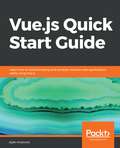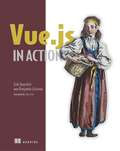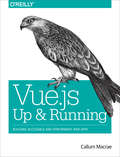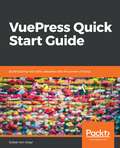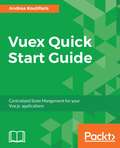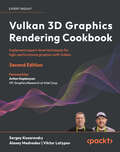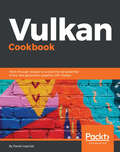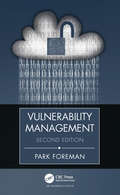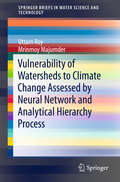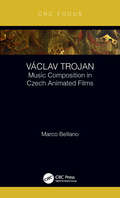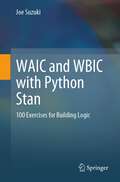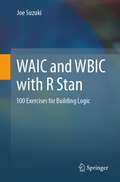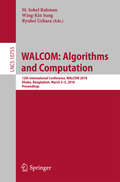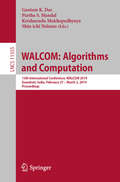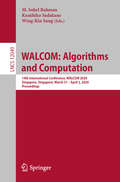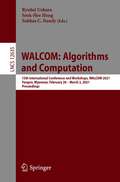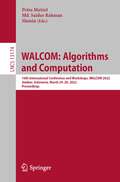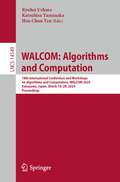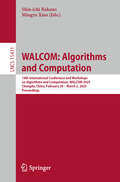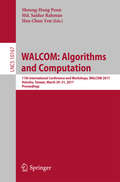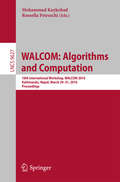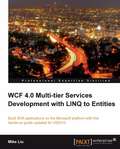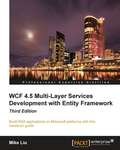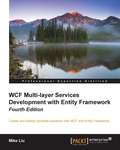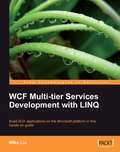- Table View
- List View
Vue.js Quick Start Guide: Learn how to build amazing and complex reactive web applications easily using Vue.js
by Ajdin ImsirovicLearn and explore all important features of Vue.js through a number of simple examples.Key FeaturesUses latest features such as Vue-cli 3, Vuex, and NuxtPractical examples to understand Vue 2 quicklyStep-by-step approach to reinforce concepts coveredBook DescriptionVue.js is the latest trending frontend framework. Simplicity, reactivity, and flexibility are some of the key benefits that Vue offers to developers. This book will help you learn everything you need to know to build stunning reactive web apps with Vue.js 2 quickly and easily.This book will take you through the Vue 2 framework. You will start by learning the different Vue installation options: CDN, NPM, and Vue CLI. Then we will look at the core concepts of Vue: templates and components – ways to modularize Vue code. You will learn how to utilize directives, which are Vue-specific HTML attributes with additional features. Also, you will see how Vue uses a streamlined approach to development, with reusable methods, computed properties, and watchers, and how it controls state with the help of its data option.You will learn about the concepts of reactive programming in Vue, and how to understand communication between parent and child components. We will take a look at props and slots, working with CSS, filters, and mixins. We will also look at ways to add transitions and animations to Vue apps. Then you will extend Vue by building custom directives and your own plugins. Finally, you will learn about Vuex – a Vue plugin that allows us to centralize state, and also introduce Nuxt, which is a framework that builds on top of Vue and solves some issues of single-page applications. After learning about these components, you will be ready to build your own reactive web apps with Vue.js 2.What you will learnDevelop apps with Vue.jsReuse components using slotsUse filters, mixins, and global mixins in VueBuild custom directives in VueWork with CSS animationsWork with templates, directives, methods, data, computed properties, and watchersUse Nuxt and Vue-RouterBuild and deploy an SSR Vue appWho this book is forThis book is for people who want to learn and experience developing with Vue.js. Familiarity with HTML, CSS, and JavaScript will help you get the most from this book.
Vue.js in Action
by Erik Hanchett Ben ListwonVue.js is a front-end framework that builds on many of the reactive UI ideas introduced in React.js. Vue.js in Action teaches readers to build fast, flowing web UI with the Vue.js framework. As they move through the book, readers put their skills to practice by building a complete web store application with product listings, a checkout process, and an administrative interface!Purchase of the print book includes a free eBook in PDF, Kindle, and ePub formats from Manning Publications.
Vue.js: Building Accessible and Performant Web Apps
by Callum MacraeGet a brisk introduction to building fast, interactive single-page web applications with Vue.js, the popular JavaScript framework that organizes and simplifies web development. With this practical guide, you’ll quickly move from basics to custom components and advanced features—including JSX, the JavaScript syntax extension.Author Callum Macrae shows you how to use the most useful libraries in the Vue ecosystem, such as vue-router for routing, vuex for state management, and vue-test-utils for testing. If you’re a frontend developer familiar with JavaScript, HTML, and CSS, this book will show you how to develop a fully featured web application using Vue.Learn Vue.js basics, including its use of templates to display data on a pageSet up Vue projects from scratch, or use vue-cli to set up from a templateCreate a maintainable codebase by splitting code into self-contained componentsDiscover how Vue.js works with CSS to style your websites and applicationsUse render functions and JSX, rather than templates, to determine what Vue displaysControl how code is executed and displayed with vue-routerManage state in one centralized place with the Vuex libraryWrite unit tests to ensure your Vue components don’t break in the future
VuePress Quick Start Guide: Build blazing-fast static websites with the power of Vue.js
by Sufyan Bin UzayrA fast paced that will teach you to build Static JavaScript Sites and Amazing Web Apps Using VuePressKey FeaturesBuild quick, SEO-friendly static websites with VuePress and Vue.jsDevelop and maintain your sites long termUse the power of Vue + webpack, and develop custom themes with VueBook DescriptionWhat are static site generators, why do you need them, and how are they better than general blogging or writing or content tools? This book answers all those questions as you learn how to build sites with VuePress. This book teaches you how to build static sites in VuePress in no time. All the site content is rendered as HTML by VuePress and is then executed as a single-page web app. This means everything works fast and loads quickly. You will start by installing and setting up the VuePress static site generator. You will learn about the powerful JavaScript framework Vue.js, which underpins VuePress, looking at its uses and advantages. You will then dig deep into the specifics of VuePress, covering content creation in Markdown, customization, internationalization, and deployment. You will also learn about security methods, configuration files for new installations, and many other techniques to have you building your own sites safely and quickly.By the end of the book, you will have built your own static website by leveraging the power of Vue.js and VuePress.What you will learnPut together a simple site in MarkdownUse VuePress to generate a super-fast static siteCustomize the appearance of your VuePress site using custom themesWork with internationalization and localize your site in multiple languagesSet up a custom home page with a call to action button as well as other pages and a navigation menuDeploy your JavaScript site to services such as Heroku, and NetlifyWho this book is forIf you want to create static sites easily, this book is for you. No knowledge of VuePress is required, but some experience with JavaScript will be helpful.
Vuex Quick Start Guide: Centralized State Management for your Vue.js applications
by Andrea KoutifarisDevelop consistent web apps with Vuex by easily centralizing the state of your applicationKey FeaturesUncover the hidden features of Vuex to build applications that are powerful, consistent, and maintainableEnforce a Flux-like application architecture in your Vue applicationTest your Vuex elements and Vue components using Karma/Jasmine testing frameworkBook DescriptionState management preserves the state of controls in a user interface. Vuex is a state management tool for Vue.js that makes the architecture easier to understand, maintain and evolve. This book is the easiest way to get started with Vuex to improve your Vue.js application architecture and overall user experience.Our book begins by explaining the problem that Vuex solves, and how it helps your applications. You will learn about the Vuex core concepts, including the Vuex store, changing application state, carrying out asynchronous operations and persisting state changes, all with an eye to scalability.You will learn how to test Vuex elements and Vue components with the Karma and Jasmine testing frameworks. You will see this in the context of a testing first approach, following the fundamentals of Test Driven Development. TDD will help you to identify which components need testing and how to test them. You will build a full Vuex application by creating the application components and services, and persist the state.Vuex comes with a plugin system that allows programmers to extend Vuex features. You will learn about some of the most powerful plugins, and make use of the built-in logger plugin. You write a custom Google Analytics plugin to send actions to its analytics API, and an Undo/Redo plugin.What you will learnMoving from classical MVC to a Flux-like architectureImplementing predictable centralized state management in your applications using VuexUsing ECMAScript 6 features for developing a real applicationUsing webpack in conjunction with Vue single file componentsTesting your Vue/Vuex applications using Karma/Jasmine and inject-loaderSimple and effective Test Driven DevelopmentExtending your application with Vuex pluginsWho this book is forIf you are a JavaScript developer, working on Vue.js and want to extend your web development skills to develop and maintain bigger applications using state management, then this book is for you. No knowledge of Vuex is required.
Vulkan 3D Graphics Rendering Cookbook: Implement expert-level techniques for high-performance graphics with Vulkan
by Viktor Latypov Sergey Kosarevsky Alexey MedvedevMaster Vulkan 1.3 with practical recipes for building, rendering, and optimizing stunning 3D graphics, guided by AR and rendering experts Sergey Kosarevsky and Alexey Medvedev Purchase the eBook for full-color contentKey FeaturesLearn to harness Vulkan 1.3 for building high-performance applicationsIntegrate cutting-edge rendering techniques into a real-time 3D engineUse bindless Vulkan to render complex 3D scenes efficientlyPurchase of the print or Kindle book includes a free PDF eBookBook DescriptionWritten by experts with decades of rendering experience, this cookbook equips you with practical, hands-on recipes to master modern 3D graphics development by using bindless Vulkan. Focusing on Vulkan 1.3, this second edition starts by setting up your development environment, and quickly transitions to building a robust 3D rendering framework using self-contained recipes. Each recipe helps you incrementally enhance your codebase, integrating a variety of 3D rendering techniques and algorithms into a cohesive project. You’ll get to grips with core techniques, such as glTF 2.0 physically based rendering, image-based lighting, and GPU-driven rendering. The chapters help you grasp advanced topics, including glTF animations, screen-space rendering techniques, and optimization strategies. You’ll also learn how to use glTF 2.0 advanced PBR extensions and handle complex geometry data, ensuring your rendering engine is both powerful and performant. These new additions will enable you to create dynamic and realistic 3D graphics environments, fully utilizing Vulkan’s capabilities. By the end of this 3D rendering book, you’ll have gained an improved understanding of best practices used in modern graphic APIs and be able to create fast and versatile 3D rendering frameworks.What you will learnMaster the core features of Vulkan 1.3, with a focus on bindless renderingLearn effective techniques for debugging and profiling Vulkan applicationsBuild a glTF 2.0 physically based rendering pipeline from scratchEnhance visual quality with advanced glTF 2.0 PBR extensionsIntegrate multiple rendering techniques and optimizations into a single applicationManage large-scale content efficiently in real-time 3D rendering enginesLeverage Vulkan compute pipelines for advanced image and geometry processingWho this book is forThis book is for 3D graphics developers who want to build high-performance rendering engines with the latest Vulkan features and modern rendering methods. Whether you’re an experienced developer with a solid grasp of 3D rendering math or someone proficient in C++ and basic linear algebra, this book offers valuable insights to deepen your expertise. If you’ve dabbled in creating custom 3D applications without relying on premade rendering engines, you’ll find this guide particularly useful.
Vulkan Cookbook
by Pawel LapinskiWork through recipes to unlock the full potential of the next generation graphics API—Vulkan About This Book • This book explores a wide range of modern graphics programming techniques and GPU compute methods to make the best use of the Vulkan API • Learn techniques that can be applied to a wide range of platforms desktop, smartphones, and embedded devices • Get an idea on the graphics engine with multi-platform support and learn exciting imaging processing and post-processing techniques Who This Book Is For This book is ideal for developers who know C/C++ languages, have some basic familiarity with graphics programming, and now want to take advantage of the new Vulkan API in the process of building next generation computer graphics. Some basic familiarity of Vulkan would be useful to follow the recipes. OpenGL developers who want to take advantage of the Vulkan API will also find this book useful. What You Will Learn • Work with Swapchain to present images on screen • Create, submit, and synchronize operations processed by the hardware • Create buffers and images, manage their memory, and upload data to them from CPU • Explore descriptor sets and set up an interface between application and shaders • Organize drawing operations into a set of render passes and subpasses • Prepare graphics pipelines to draw 3D scenes and compute pipelines to perform mathematical calculations •Implement geometry projection and tessellation, texturing, lighting, and post-processing techniques •Write shaders in GLSL and convert them into SPIR-V assemblies •Find out about and implement a collection of popular, advanced rendering techniques found in games and benchmarks In Detail Vulkan is the next generation graphics API released by the Khronos group. It is expected to be the successor to OpenGL and OpenGL ES, which it shares some similarities with such as its cross-platform capabilities, programmed pipeline stages, or nomenclature. Vulkan is a low-level API that gives developers much more control over the hardware, but also adds new responsibilities such as explicit memory and resources management. With it, though, Vulkan is expected to be much faster. This book is your guide to understanding Vulkan through a series of recipes. We start off by teaching you how to create instances in Vulkan and choose the device on which operations will be performed. You will then explore more complex topics such as command buffers, resources and memory management, pipelines, GLSL shaders, render passes, and more. Gradually, the book moves on to teach you advanced rendering techniques, how to draw 3D scenes, and how to improve the performance of your applications. By the end of the book, you will be familiar with the latest advanced techniques implemented with the Vulkan API, which can be used on a wide range of platforms. Style and approach This recipe-based guide will empower you to implement modern graphic programming techniques and help gain a solid understanding of the new Vulkan API.
Vulnerability Management
by Park ForemanVulnerability management (VM) has been around for millennia. Cities, tribes, nations, and corporations have all employed its principles. The operational and engineering successes of any organization depend on the ability to identify and remediate a vulnerability that a would-be attacker might seek to exploit. What were once small communities became castles. Cities had fortifications and advanced warning systems. All such measures were the result of a group recognizing their vulnerabilities and addressing them in different ways. Today, we identify vulnerabilities in our software systems, infrastructure, and enterprise strategies. Those vulnerabilities are addressed through various and often creative means. Vulnerability Management demonstrates a proactive approach to the discipline. Illustrated with examples drawn from Park Foreman’s more than three decades of multinational experience, the book demonstrates how much easier it is to manage potential weaknesses than to clean up after a violation. Covering the diverse realms that CISOs need to know and the specifics applicable to singular areas of departmental responsibility, he provides both the strategic vision and action steps needed to prevent the exploitation of IT security gaps, especially those that are inherent in a larger organization. Completely updated, the second edition provides a fundamental understanding of technology risks—including a new chapter on cloud vulnerabilities and risk management—from an interloper’s perspective. This book is a guide for security practitioners, security or network engineers, security officers, and CIOs seeking understanding of VM and its role in the organization. To serve various audiences, it covers significant areas of VM. Chapters on technology provide executives with a high-level perspective of what is involved. Other chapters on process and strategy, although serving the executive well, provide engineers and security managers with perspective on the role of VM technology and processes in the success of the enterprise.
Vulnerability of Watersheds to Climate Change Assessed by Neural Network and Analytical Hierarchy Process
by Mrinmoy Majumder Uttam RoyThe increase in GHG gases in the atmosphere due to expansions in industrial and vehicular concentration is attributed to warming of the climate world wide. The resultant change in climatic pattern can induce abnormalities in the hydrological cycle. As a result, the regular functionality of river watersheds will also be affected. This Brief highlights a new methodology to rank the watersheds in terms of its vulnerability to change in climate. This Brief introduces a Vulnerability Index which will be directly proportional to the climatic impacts of the watersheds. Analytical Hierarchy Process and Artificial Neural Networks are used in a cascading manner to develop the model for prediction of the vulnerability index.
Václav Trojan: Music Composition in Czech Animated Films
by Marco BellanoThis book explores the Czech composer Václav Trojan (1907-1983) and his compositions for Jiri Trnka's films, a very influential puppet stop-motion animator. Trnka is regarded as one of the finest outcomes of Czech art in the aftermath of the Second World War and inspiration for contemporary directors like Tim Burton and companies such as Aardman or Laika. Trojan's music for animation sets a great artistic model in European animation, at least as meaningful as Carl Stalling's music for Warner Bros. cartoons in the USA. Trojan was an eclectic artist, which encompassed folk songs, jazz and blues influences, neoclassical symphonic and chamber works, opera and more. Key Features: A historical overview of the origins and early development of Czech animation Biographical sketches and stylistic outline of both Trnka and Trojan An audiovisual analysis of all the available Trnka films Trojan wrote music for Filmography and bibliography
WAIC and WBIC with Python Stan: 100 Exercises for Building Logic
by Joe SuzukiMaster the art of machine learning and data science by diving into the essence of mathematical logic with this comprehensive textbook. This book focuses on the widely applicable information criterion (WAIC), also described as the Watanabe-Akaike information criterion, and the widely applicable Bayesian information criterion (WBIC), also described as the Watanabe Bayesian information criterion. The book expertly guides you through relevant mathematical problems while also providing hands-on experience with programming in Python and Stan. Whether you’re a data scientist looking to refine your model selection process or a researcher who wants to explore the latest developments in Bayesian statistics, this accessible guide will give you a firm grasp of Watanabe Bayesian Theory.The key features of this indispensable book include:A clear and self-contained writing style, ensuring ease of understanding for readers at various levels of expertise.100 carefully selected exercises accompanied by solutions in the main text, enabling readers to effectively gauge their progress and comprehension.A comprehensive guide to Sumio Watanabe’s groundbreaking Bayes theory, demystifying a subject once considered too challenging even for seasoned statisticians.Detailed source programs and Stan codes that will enhance readers’ grasp of the mathematical concepts presented.A streamlined approach to algebraic geometry topics in Chapter 6, making Bayes theory more accessible and less daunting.Embark on your machine learning and data science journey with this essential textbook and unlock the full potential of WAIC and WBIC today!
WAIC and WBIC with R Stan: 100 Exercises for Building Logic
by Joe SuzukiMaster the art of machine learning and data science by diving into the essence of mathematical logic with this comprehensive textbook. This book focuses on the widely applicable information criterion (WAIC), also described as the Watanabe-Akaike information criterion, and the widely applicable Bayesian information criterion (WBIC), also described as the Watanabe Bayesian information criterion. This book expertly guides you through relevant mathematical problems while also providing hands-on experience with programming in R and Stan. Whether you’re a data scientist looking to refine your model selection process or a researcher who wants to explore the latest developments in Bayesian statistics, this accessible guide will give you a firm grasp of Watanabe Bayesian Theory.The key features of this indispensable book include:A clear and self-contained writing style, ensuring ease of understanding for readers at various levels of expertise.100 carefully selected exercises accompanied by solutions in the main text, enabling readers to effectively gauge their progress and comprehension.A comprehensive guide to Sumio Watanabe’s groundbreaking Bayes theory, demystifying a subject once considered too challenging even for seasoned statisticians.Detailed source programs and Stan codes that will enhance readers’ grasp of the mathematical concepts presented.A streamlined approach to algebraic geometry topics in Chapter 6, making Bayes theory more accessible and less daunting.Embark on your machine learning and data science journey with this essential textbook and unlock the full potential of WAIC and WBIC today!
WALCOM: 12th International Conference, WALCOM 2018, Dhaka, Bangladesh, March 3-5, 2018, Proceedings (Lecture Notes in Computer Science #10755)
by M. Sohel Rahman Wing-Kin Sung Ryuhei UeharaThis book constitutes the proceedings of the 12th International Workshop on Algorithms and Computation, WALCOM 2018, held in Dhaka, Bangladesh, in March 2018.The 22 full papers presented were carefully reviewed and selected from 50 submissions. The papers cover diverse areas of algorithms and computation, such as approximation algorithms, computational geometry, combinatorial algorithms, computational biology, computational complexity, data structures, graph and network algorithms, and online algorithms.
WALCOM: 13th International Conference, WALCOM 2019, Guwahati, India, February 27 – March 2, 2019, Proceedings (Lecture Notes in Computer Science #11355)
by Shin-Ichi Nakano Gautam K. Das Partha S. Mandal Krishnendu MukhopadhyayaThis book constitutes the proceedings of the 13th International Conference and Workshop on Algorithms and Computation, WALCOM 2019, held in Guwahati, India, in February/ March 2019. The 30 full papers presented were carefully reviewed and selected from 100 submissions. The papers are organized in topical headings on the facility location problem; computational geometry; graph drawing; graph algorithms; approximation algorithms; miscellaneous; data structures; parallel and distributed algorithms; and packing and covering.
WALCOM: 14th International Conference, WALCOM 2020, Singapore, Singapore, March 31 – April 2, 2020, Proceedings (Lecture Notes in Computer Science #12049)
by Kunihiko Sadakane M. Sohel Rahman Wing-Kin SungThis book constitutes the refereed proceedings of the 14th International Conference on Algorithms and Computation, WALCOM 2020, held in Singapore in March/April 2020. The 23 full and 4 short papers presented were carefully reviewed and selected from 66 submissions. The papers focus on algorithmic graph theory and combinatorics, computational biology, computational geometry, data structures, experimental algorithm methodologies, graph algorithms, graph drawing, parallel and distributed algorithms, network optimization.
WALCOM: 15th International Conference and Workshops, WALCOM 2021, Yangon, Myanmar, February 28 – March 2, 2021, Proceedings (Lecture Notes in Computer Science #12635)
by Ryuhei Uehara Seok-Hee Hong Subhas C. NandyThis book constitutes the proceedings of the 15th International Conference on Algorithms and Computation, WALCOM 2021, which was planned to take place in Yangon, Myanmar in February/March 2021. The conference changed to an online format due to the COVID-19 pandemic. The 24 full papers included in this volume were carefully reviewed and selected from a total of 60 submissions. They cover diverseareas of algorithms and computation, such as approximation algorithms, algorithmic graph theory and combinatorics, combinatorial algorithms, combinatorial optimization, computational biology, computational complexity, computational geometry, discrete geometry, data structures, experimental algorithm methodologies, graph algorithms, graph drawing, parallel and distributed algorithms, parameterized algorithms, parameterized complexity, network optimization, online algorithms, randomized algorithms, and string algorithms.
WALCOM: 16th International Conference and Workshops, WALCOM 2022, Jember, Indonesia, March 24–26, 2022, Proceedings (Lecture Notes in Computer Science #13174)
by Md. Saidur Rahman Petra Mutzel SlaminThis book constitutes the proceedings of the 16th International Conference on Algorithms and Computation, WALCOM 2022, which was held in Jember, Indonesia, during March 24-26, 2022.This proceedings volume contains 30 full papers which were carefully reviewed and selected from a total of 89 submissions and 3 invited papers. They cover diverse areas of algorithms and computation, such as approximation algorithms, computational complexity, computational geometry, graph algorithms, graph drawing and visualization, online algorithms, parameterized complexity and property testing.
WALCOM: 18th International Conference and Workshops on Algorithms and Computation, WALCOM 2024, Kanazawa, Japan, March 18–20, 2024, Proceedings (Lecture Notes in Computer Science #14549)
by Hsu-Chun Yen Ryuhei Uehara Katsuhisa YamanakaThis book constitutes the refereed proceedings of the 18th International Conference and Workshops on Algorithms and Computation, WALCOM 2024, held in Kanazawa, Japan, during March 18–20, 2024. The 28 full papers presented in this book, together with two extended abstracts of invited talks, were carefully reviewed and selected from 80 submissions. They cover diverse areas of algorithms and computation, that is, approximation algorithms, algorithmic graph theory and combinatorics, combinatorial algorithms, combinatorial optimization, computational biology, combinatorial reconfiguration, computational complexity, computational geometry, discrete geometry, data structures, experimental algorithm methodologies, graph algorithms, graph drawing, parallel and distributed algorithms, parameterized algorithms, parameterized complexity, network optimization, online algorithms, randomized algorithms, and string algorithms.
WALCOM: 19th International Conference and Workshops on Algorithms and Computation, WALCOM 2025, Chengdu, China, February 28 – March 2, 2025, Proceedings (Lecture Notes in Computer Science #15411)
by Shin-Ichi Nakano Mingyu XiaoThis book LNCS 15411 constitutes the refereed proceedings of the 19th International Conference and Workshops on Algorithms and Computation, WALCOM 2025, held in Chengdu, China, during February 28 – March 2, 2025. The 26 full papers were carefully reviewed and selected from 68 submissions. WALCOM 2025 covered a wide range of topics, including approximation algorithms, algorithmic graph theory and combinatorics, algorithmic and combinatorial aspects of logic, combinatorial algorithms, combinatorial optimization, combinatorial reconfiguration, computational biology, computational complexity, computational geometry, discrete geometry, data structures, experimental algorithm methodologies, graph algorithms, graph drawing, parallel and distributed algorithms, parameterized algorithms and complexity, network optimization, online algorithms, randomized algorithms, and string algorithms.
WALCOM: Algorithms and Computation
by Sheung-Hung Poon Md. Saidur Rahman Hsu-Chun YenThis book constitutes the proceedings of the 11th International Workshop on Algorithms and Computation, WALCOM 2017, held in Hsinchu, Taiwan, in March 2017. The 35 full papers presented together with three invited talks were carefully reviewed and selected from 83 submissions. The papers are organized in topical sections on invited talks; computational geometry; combinatorial optimization; graph drawing; graph algorithms; space-efficient algorithms; computational complexity; approximation algorithms.
WALCOM: Algorithms and Computation
by Rossella Petreschi Mohammad KaykobadThis book constitutes the proceedings of the 10th International Workshop on Algorithms and Computation, WALCOM 2016, held in Kathmandu, Nepal, in March 2016. The 27 full papers presented together with 4 invited talks were carefully reviewed and selected from 68 submissions. The papers cover a wide range of topics such as approximation algorithms, computational complexity, computational geometry, data structures, graph algorithms, graph coloring, graph exploration, and online algorithms.
WCF 4.0 Multi-tier Services Development with LINQ to Entities
by Mike LiuThis book is a step-by-step tutorial to guide you through learning WCF and LINQ to Entities. You will be guided to create five WCF and LINQ solutions from scratch, of which three are multi-tiered real-world WCF service solutions, so you will not only be reading, but also be coding through the book, to gain practical experience of WCF and LINQ to Entities. Various test clients will be associated with each solution and these solutions can be built and run independently of other solutions. Clear step-by-step instructions and relevant screenshots will make sure you won't get lost in the new world of WCF and LINQ to Entities. Configuration files, host applications, test clients, and WCF services for each solution will also be available for download for you to examine, modify, and debug from the outside in. The book focuses on the essentials of using WCF and LINQ to Entities, rather than providing a reference to every single possibility. It leaves the reference material online where it belongs, and concentrates instead on practical examples, code, and advice. This book is for C# and C++ developers who are eager to get started with WCF and LINQ to Entities, and want a book that is practical and rich with examples from the very beginning. Developers and architects evaluating SOA implementation technologies for their company will find this book particularly useful because it gets you started with Microsoft's tools for SOA and shows you how to customize our examples for your prototypes. This book presumes basic knowledge of C# or C++. Previous experience with Visual Studio will be helpful but is not required, as detailed instructions are given throughout the book.
WCF 4.5 Multi-Layer Services Development with Entity Framework
by Mike LiuThis book is a step-by-step tutorial to guide you through learning WCF and Entity Framework. Clear step-by-step instructions and relevant screenshots will make sure you won't get lost in the new world of WCF and Entity Framework.Configuration files, host applications, test clients, and WCF services for each solution will also be available for download for you to examine, modify, and debug from the outside in.The book focuses on the essentials of using WCF and Entity Framework, rather than providing a reference to every single possibility. It leaves the reference material online where it belongs, and concentrates instead on practical examples, code, and advice.This book is for C#, VB.NET, and C++ developers who are eager to get started with WCF and Entity Framework, and want a book that is practical and rich with examples from the very beginning.Developers and architects evaluating SOA implementation technologies for their company will find this book particularly useful because it gets you started with Microsoft's tools for SOA and shows you how to customize our examples for your prototypes.This book presumes basic knowledge of C# or C++.Previous experience with Visual Studio will be helpful but is not required, as detailed instructions are given throughout the book.
WCF Multi-layer Services Development with Entity Framework - Fourth Edition
by Mike LiuIf you are a C#, VB.NET, or C++ developer and want to get started with WCF and Entity Framework, then this book is for you. Competence in Entity Framework will be needed to follow the examples in the book, but experience in creating WCF services using Entity Framework is not necessary. Developers and architects evaluating SOA implementation technologies for their company will find this book useful.
WCF Multi-tier Services Development with LINQ
by Mike LiuThis book is a step-by-step tutorial with clear instructions and screenshots to guide you through the creation of a multi-tier real-world WCF service solution. Configuration files, host applications, test clients, and WCF services for each solution will be available for download on this website for you to examine, modify, and debug from the outside to the inside.The book focuses on the essentials of using WCF and LINQ, rather than providing a reference to every single possibility. It leaves the reference material online where it belongs, and concentrates instead on practical examples, code, and advice.This book is for C# and C++ developers who are eager to get started with WCF and LINQ, and want a book that is practical and rich with examples from the very beginning. Developers and architects evaluating SOA implementation technologies for their company will find this book particularly useful because it gets you started with Microsoft's tools for SOA and shows you how to customize our examples for your prototypes.This book presumes basic knowledge of C# or C++. Previous experience with Visual Studio will be helpful but is not required, as detailed instructions are given throughout the book.
